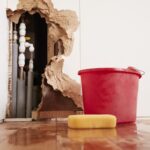Every winter, homeowners are plagued by ice dams. Because ice dams occur on roofs buried in snow, few people actually see them, let alone understand their causes.
What Is an Ice Dam?
An ice dam is a chunk of ice that collects along the lower edge of rooflines. These ice dams occur in climates with cold winter temperatures and regular snowfalls. Multiple ice dams can weigh hundreds of pounds, which can put a great pressure on the structure of the roof eaves. Furthermore, ice dams can cause melt-water to back up under the shingles, where it can flow down and damage ceiling and wall surfaces in your hone. If not addressed, ice dams can cause serious damage to your roof, gutters, paint, insulation and interior drywall and other surfaces.
What Causes an Ice Dam?
Ice dams occur most often in heavy snowfall and cold temp conditions, but they can occur with just an a few inches of snow. Some part of your roof warms up enough to melt the snow. The melt water flows down to another part of the roof that is cooler, and the water refreezes. The ice forms a small dam that builds up slowly as more melt water refreezes. Eventually, water backs up behind the dam and works its way up under the shingles until it begins to leak through the roof into the living space below.
There are four main causes of ice damming
Weather
Household heat escaping to the attic
Uneven roof temperatures
Roofing underlayment that water can penetrate
How to Get Rid Get Rid of Roof Ice Dams
If you already have an ice dam on your roof and are searching for a way to get rid of the ice dam before damage occurs, the following can be great solutions. Please consider your safety when performing any of these tasks in order to not cause further roof damage or injuries. tricks will combat the current problem at hand, but if you’re looking
Use a rake to safely remove excess snow or ice. This will release any water that may have built up underneath and change the temperature on the roof’s exterior. It is important to note that homeowners should not try to remove ice dams with shovels or other sharp tool. This would be a dangerous task, and will cause more damage to the roof.
Create a path to release excess water. Using ice melt or a heated cable, you can clear a trail between ice structures for the excess water to break through to the gutters. Before you attempt this, it is important to check that the gutters are clear and will be able to drain the meltwater properly.
Freeze existing leaks to prevent further damage. If you’re experiencing roof leaks because the ice dam has already started harming the property, try to stop the water from running into your house and causing additional problems. We recommend doing this by temporarily turning down the temperature and aiming a fan at the source of a current leak. This will allow you to freeze the leak while you tackle one of the other approaches to remove the excess water, then patch the leak.
About Community Public Adjusters
Community Public Adjusters specializes in homeowners and business insurance claim representation. Our public adjusters and property loss consultants work diligently to make sure you get the maximum possible settlement from the insurance company regarding your insurance claim.
We offer claim representation services on a contingency basis, if we do not collect any funds for you, we do not get paid at all. Community Public Adjusters has expert knowledge on how the insurance claim process works. We work with you on every step of the claims process.
We represent home and business owners and have vast experience with the following types of claims
- Fire and smoke damage claims
- Water damage claims
- Flood damage claims
- Theft and vandalism damage claims
- Snow and ice damage claims
- Building collapse claims
- Wind and hail damage claims
- Catastrophic damage claims
- Roof leaks
- Blown off shingles & siding
- All plumbing leaks
- Toilet overflow
- Burst Pipes
- Frozen Pipes





